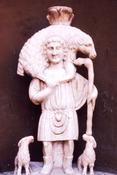This Christian text you've never heard of, The Shepherd of Hermas, barely mentions Jesus − but it was a favorite of early Christians far and wide
Published in News & Features
People usually think about the Bible as a book with a fixed number of texts within its pages: 24 books in the Jewish version of the Bible; 66 for Protestants; 73 for Catholics; 81 if you’re Ethiopian Orthodox.
Writings that didn’t make it into the Bible, on the other hand, are often called “apocrypha,” a Greek term that refers to hidden or secret things. There are hundreds of apocryphal Jewish and Christian texts that, for one reason or another, were not included in different versions of the Bible. Some simply fell out of use. Some caused theological headaches for later Jews or Christians, and some were rejected because of their author – for supposedly not having really been written by an apostle, for instance. (When used with a capital “A,” Apocrypha refers to a handful of books included in the Catholic and Orthodox versions of the Old Testament, but not most Protestant ones.)
Just because a text was deemed apocryphal, however, does not mean that it was unpopular or lacked influence. Many texts that are treated as unimportant or unbiblical today were considered central at one time. As a scholar of early Christianity, some of my research centers on what was once an extremely well-read text, but one that most people today have never heard of: The Shepherd of Hermas.
The Shepherd of Hermas was written sometime between 70–140 C.E. and takes place on the road between Rome and Naples. Hermas, who is presented as the text’s author and narrator, has various encounters with two divine figures called the Church and the Shepherd, who give him commandments and visions that he is instructed to share with other believers.
The Shepherd is a sizable text – 114 chapters long – and substantial portions describe a vision of a tower under construction. The tower represents the church itself, in the sense of all Jesus’ followers, built out of stones that represent different types of believers. Some fit right in, others must be reshaped or recolored, and some are rejected altogether. For example, stones representing rich people or businessmen are urged to repent, while hospitable people are portrayed as properly shaped.
Other parts of the text are focused on how believers should manage their emotions, how to act ethically in the world and how to obey God’s will. The Shepherd urges self-control and fear of God, trying to instill obedience and avoid allowing emotions like fear or doubt to overcome believers.
My own research on the Shepherd focuses on how the text depicts believers as enslaved to God, as is true of some other early Christian literature as well. The writer imagines that God’s holy spirit is able to enter loyal believers’ bodies and possess them, urging them to do what God wills.
Notably, figures like Jesus and the apostles are virtually absent from the Shepherd. Instead, readers find a story about an otherwise unknown enslaved man named Hermas experiencing visions and talking with divine beings in the Italian countryside. Hermas is portrayed as a believer who doubts his own ability to accomplish what these two divine figures, the Church and Shepherd, expect of him, lamenting throughout how difficult it is to follow God’s commandments.
Given that the Shepherd is a long, rambling text that doesn’t explicitly mention Jesus, you might assume that it was only read by a small number of early Christian theologians. This, however, isn’t the case.
The Shepherd became one of the most popular texts among Christians for the first five centuries C.E. Even today, there are more surviving manuscripts of the Shepherd from antiquity than of any New Testament text except for the Gospels of Matthew and John.
The visions were translated from Greek into Latin, Coptic, Ethiopic, Arabic and Georgian. Eventually, the text spread as far west as Ireland and as far east as China.
The Shepherd is even included in what scholars consider one of the oldest and most complete Bibles in the world. Canonical Christian Bibles today end with Revelation, a dramatic book of apocalyptic visions. The Codex Sinaiticus, however, a fourth- or fifth-century manuscript now held at the British Library, ends with the Shepherd. The text’s inclusion in such an expensive, deluxe codex highlights how important the text was to many Christians, even as the contents of the New Testament were being solidified.
Many significant Christian writers from the fourth and fifth centuries comment on how the Shepherd is important instruction for new Christians, regardless of whether it was considered part of the formal Bible.
Even figures who did not include the Shepherd among New Testament texts thought it was too important to be discarded. The book was too important to ignore, but too odd to be considered biblical: part of a halfway category that biblical scholar François Bovon called “useful for the soul.”
As the Shepherd helps demonstrate, whether a religious text is included or excluded from the Bible is not necessarily an indicator of its popularity or significance.
While scholars often lament that the Shepherd is boring, pedantic or too long, its style likely made it ideal teaching material for early Christians. Esoteric texts that required deeper philosophical knowledge, like the Gospel of Truth or Gospel of Judas, may have been ideal for some Christians who had access to more education. But texts that make bite-sized claims – like “don’t think about another man’s wife” (Shepherd 29:1), “rid yourself of grief” (Shepherd 40:1), or “believe that God is one” (Shepherd 26:1) – are easier for readers to carry with them and apply to everyday decisions in their lives.
The word “canon,” referring to texts that get a seal of approval from authorities, comes from a Greek word for a measuring stick: which books “measure up”? In religious communities, the idea of “canonical texts” can be especially limiting, determining what believers can or can’t read or believe.
Apocryphal literature, however, allows us to see how that wasn’t always the case: Ancient Christians didn’t think they were bound to the same specific set of stories that churches focus on today. The long history of reading apocrypha shows how some Christians have always been interested in reading the “Bible with the back cover torn off” – continually exploring religious ideas.
This article is republished from The Conversation, an independent nonprofit news site dedicated to sharing ideas from academic experts. If you found it interesting, you could subscribe to our weekly newsletter.
Read more:
What early Christian communities tell us about giving financial aid at a time of crises
What is biblical inerrancy? A New Testament scholar explains
Chance Bonar does not work for, consult, own shares in or receive funding from any company or organization that would benefit from this article, and has disclosed no relevant affiliations beyond their academic appointment.













Comments